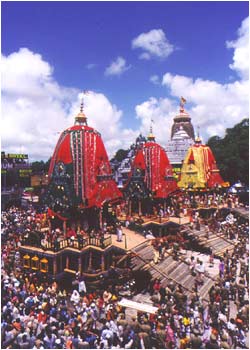Car Festival of
Lord Jagannath at Puri, in Orissa, popularly known as the Rath Yatra. On this occasion
devotees join hands to pull the massive chariots of their deities over a three-kilometre
distance.
Every yearIn the month of Ashadh, according to the Hindu calendar, on the second day of
the lunar fortnight that falls during June-July, the Car Festival is held in many cities
and towns of India and recently, even abroad.
Celebration:
The three wooden deities of lord 'Jagannatha', 'Balbhadra' & 'Devi Subhadra' with
'Sudarshan' are brought out of the main temple and taken to Gundicha temple for a week's
visit in three beautifully decorated chariots.
|
 |
Specialty:
From the many specialties of the festival the most unique one is that, this is the only
occasion to see, even embrace the deities irrespective of caste, colour and creed outside
the Temple.The Sequence:
The divine procession is called Pahandi Bije. The deities are brought out of the temple to
the chariots by rhythmic movement called Pahandi in a royal procession to the
accompaniment of the beat of the cymbals and drums and chanting of prayers by devotees.
The chariots are swept clean after the bringing of the devotees and placing them in the
chariot. The sweeping is done by the traditional king of Puri with a golden broom called
Chhera Pahanra. The deities are then placed carefully in their respective chariots. The
pulling of the Rathas is the most exciting part of the entire event. It is witnessed by
thousands of devotees at the Gundicha temple, where they stay for around a week. The
pulling is called Rathtana.
The return journey called Bahuda Yatra, takes place on Ashadha Sukla Dasami, the 10th day
of the bright fortnight of Ashadha (June-July). Before going to their original abode, the
deities are dressed in Golden attire on the Chariots the next day and the process is
termed as Suna Besha. When two months of Ashadha fall in one year, Rath Yatra is observed
as the Festival of Nabakalebar. The old deities are buried within the temple premises
(Kilibaikuntha) and are replaced by new deities, carved out of Margosa trees for which
there are set procedures. Double Ashadha occurs at intervals of 8 to 19 years. |
